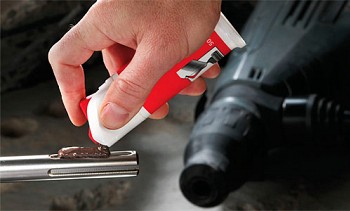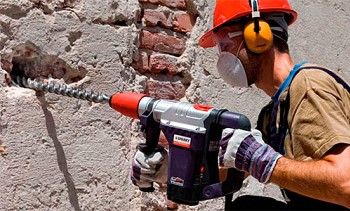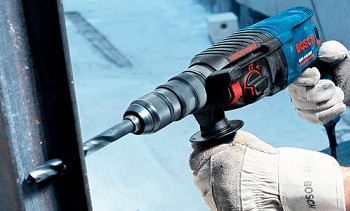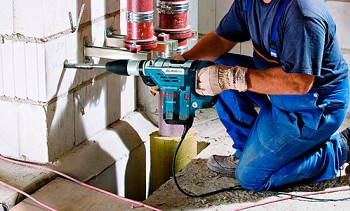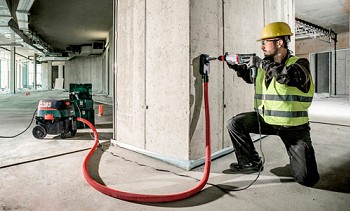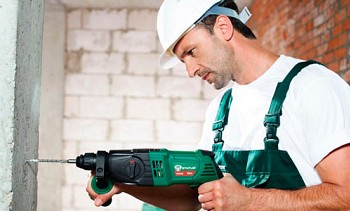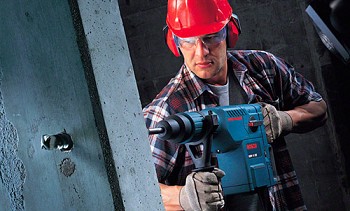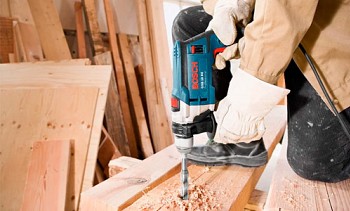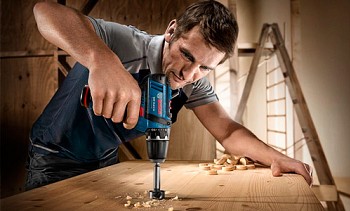The difference between a puncher and a percussion drill - let's put everything on the shelves
Looking at a window with a neatly laid out tool, just my eyes run up, impact drills, rotary hammersscrewdrivers. All of them are a bit similar in appearance, and many think that this is one and the same. Let's find out in all the details how the drill differs from the punch and in which case this or that tool can be useful to you. To begin, consider why and in which cases you can use one or another tool.
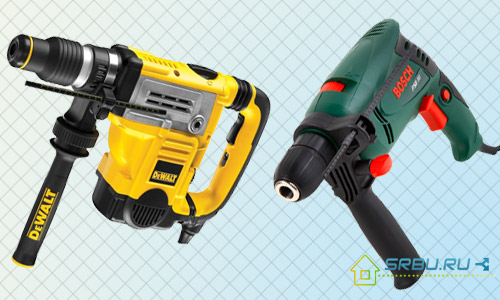
Where and why use a drill
First, let's talk about drills. Even a not quite knowledgeable person knows that it is with this tool, if necessary, that you can drill large or small holes in almost any material. If the drill is equipped with a percussion mechanism, then it is possible to break through concrete walls (that is, work in percussion mode). However, this mode is easy to turn off by switching to traditional drilling, which is very convenient. But this area of use of the drill does not end there.
Depending on what material needs to be drilled, various types of drills are used, which look different and are designed for different purposes.
1. So, drills on wood are useful for drilling a wooden surface, but in most cases they are replaced with conventional metal drills. In some cases, feather drills are used to drill wood.
2. If you have to work with metal, then drills need others - more durable, with a certain design.
3. And with tiles and glass, you should be careful - and look, instead of a flat hole, a chip will turn out. Therefore, to solve such problems, there is another type of drill - these are spear-shaped drills for ceramics and glass.
4. For making holes of large diameter, crown drills are the best option.
5. As mentioned above, when an impact drill works like a hammer drill, it can hammer concrete and brick. Although she does not become a full-fledged puncher - but she can perform work of medium degree of complexity. For these purposes, drills with victorious tips are used.
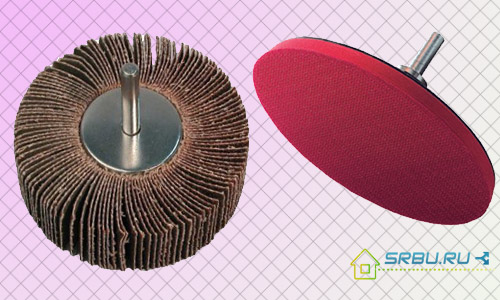
To grind the surface with a drill, it is enough to use a grinding wheel as a nozzle.
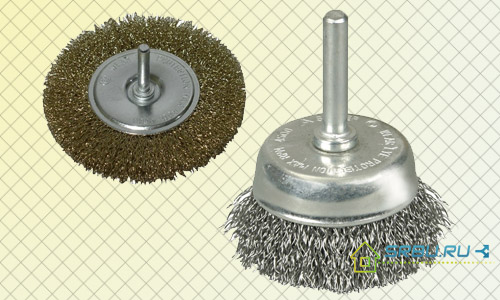
If there is a need to clean various metal surfaces on a drill, just put on a special brush made of steel wire.
If the wire in the tufts of the brush is twisted, then the processing will be rough. For finer finishes, use a corrugated wire nozzle.

If you need to mix some mass, then the drill can easily be turned into a mixer. For this, there is also a special nozzle.
Thanks to this, an impact drill is a universal device capable of performing many functions. In the presence of some additional tools, it can work with a mixer, and a screwdriver, and a grinder, or, when you turn on the chiselling mode - with a puncher.
Why use a hammer drill
This tool is used to break any materials. It is often used by both cool "pros" who have been engaged in construction and repair on an ongoing basis for several years, as well as home craftsmen.
Using a punch you can:
- drill a hole in concrete, brick, blocks
- remove the plaster;
- knock down a tile;
- crack bricks;
- gouging concrete walls.
You can’t make a repair without this tool, nor can you build a house. It is convenient to work with him - he is fast and has almost no return.
The nozzles of the device can be:
- Boers
- chisels;
- core drills;
- peaks.
As for equipment, it can have the tail of two systems.This is either SDS Max or SDS Plus.
The SDS Plus system features four oval grooves for mounting. Two of them are at the end and are open, the other two are hidden. When the shank is inserted into the cartridge, it moves along the open grooves, as along the guides. Special locking balls fix it in closed holes.
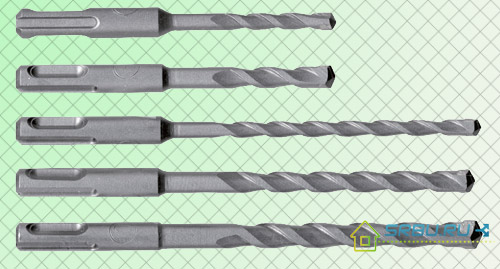
Drills with SDS Plus shanks.
The SDS Max system has not four, but five recesses for mounting. Now there are three open grooves, so the drill holds more firmly. Such a system is most often used in professional tools.
The chisel nozzle is placed on the punch when something needs to be dismantled. The peak nozzle is used to gouge the walls before laying wires or to make holes in the wall. The crown nozzle will help to make a large through hole.
Differences between the drill and the punch
The main difference is the percussion system
The most significant difference between a punch and a percussion drill is the principle of the percussion system. So, in a drill, two gear mechanisms — ratchets — are used to form the impact. The tool holder is rigidly connected with the first of them, and its body - with the second. When the impact mechanism is not needed, a stopper is inserted between the ratchets, and they have no contact. When the impact mode is activated, the stopper is removed, and the gear train converts the rotational movement of the cartridge into translational-reciprocal.
This process is simply beautifully shown in the next video clip, despite the fact that the announcer in the video constantly calls a percussion drill a perforator, in fact, the video shows the operation of a conventional percussion drill. It’s just how the translators and the announcer should know how the drill with the impact function differs from the punch, because they did not read our article :)
Video: The principle of the impact drill
The punch is different. The impact device can be either electromechanical or electro-pneumatic. Most often the first type is used. In this case, there are two coils, which during electromagnetic interaction cause the core to move back and forth. Further, the energy is transmitted directly to the working part of the punch.
The pneumatic mechanism can be of two types. Equipped with a crank gear or system with the so-called "drunk" rolling bearing. In the latter case, the rotating rotor drives the piston, which transfers the shock energy of the working part.
Video: Drunk Bearing Shock
Well, the crank mechanism transfers its rotational energy with the help of a piston, which gives a push to the working part of the hammer drill with compressed air.
Video: Shock crank mechanism
Functionality is important
In this regard, the puncher is significantly ahead of the drill - because it has as many as three operating modes. This is spin, punch with spin and just punch. Accordingly, using an electric hammer drill you can not only drill a wall, but also punch it. Gouging a large hole, drilling a groove for the cable, breaking a piece of the wall - all this can be done with such a powerful tool as a puncher. But the drill with a percussion mechanism has only two modes - standard drilling and drilling using impact. Moreover, the force of this blow is not as powerful as that of a perforator.
What are the main characteristics
For electric drills, the main characteristic is torque, or torque. The unit for measuring it is the Newton meter. Hammers are classified according to another criterion. For them, the main thing is power, which depends on the impact energy. This value is measured in joules. And the punch torque does not have to be big at all, often it is much less than a hammer drill with a similar power engine.
Performance leader
And here the puncher breaks forward again. After all, the impact energy from him, no doubt, is greater than that of a percussion drill. Therefore, working with a hammer drill is much more comfortable - it is not necessary to press it as hard as a hammer drill. Working with the latter, it will be extremely difficult to punch a hole without significant pressure.
Main application
For a drill, the main field of application is work on drilling metal, tiles and wooden surfaces. Well, the punch is designed to overcome concrete and brick walls. Therefore, in terms of hours or minutes spent, and in quality, it is difficult to compare the result of work performed by one and the other tool. Indeed, for a drill, the shock function is only an additional one. However, as well as the drilling function of the punch. Do not neglect the instruction, using the tool "to the fullest" where only a short-term mode is allowed. Sadly this will end - a good thing will break.
To summarize
Now, imagining the difference between a percussion drill and a hammer drill, the choice will be made easier. Choose a similar tool when you will be in full detail to imagine what you might need it for. If you have to work with brick and concrete, then in the store look to the side where the perforators are on the shelves. If such work as punching walls is very rare, you should not spend money on a powerful punch. It is quite possible then to do with an impact drill. It will be needed only if you intend to do such work often and for a long time.
Video: Hammer drill or hammer drill

